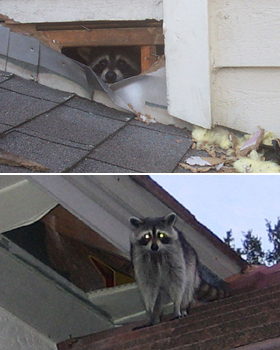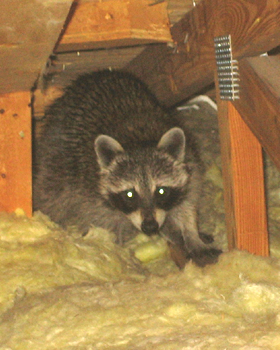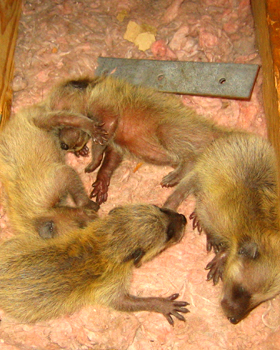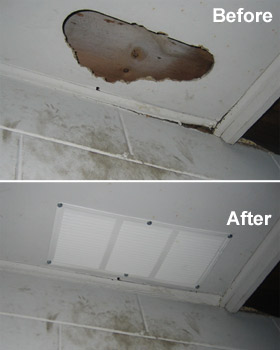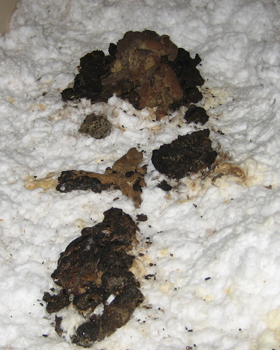WARNING: Before you start, be aware that about 85-90% of the time a raccoon is in the attic, it's a female
raccoon with a litter of baby raccoon pups (or kits). Note the time of year. Female raccoons generally give
birth in the early spring, from late Feb to late March. But this range can vary quite a bit. In warmer
climates, it can be any time of year. The bad news - with babies, you absolutely can not remove just the adult female. The
good news - mama raccoons are very particular about having a safe den, so there's a good chance you can scare her into
moving her and her young out on her own!
HUMANE HINT: Evicting a female raccoon and her young could be hard on the animals, so if you wait 8-10
months after their birth, they will be grown and move out on their own. At that time, you can seal the entry hole and
clean the attic. But being realistic, we are aware that not everyone wants this option, which is why we offer the how-to
advice below.
CAN'T I JUST CATCH IT IN A CAGE TRAP? This is a bad idea for several reasons, but if you attempt this, and
do catch a raccoon, look at the belly. If you can see nipples, it's a lactating female with a litter of young. Moving the
female away at this point means weeks of starvation (babies are very tough) and then death for the babies. If you relocate
the mother, she will desperately travel many miles to try to get back to her young, and studies show she often dies in this
process (hit by car, not feeding, etc). We do not recommend trapping.
STEP 1 - Inspect the exterior of the house. You should find an obvious entry point, a hole large enough for
an adult raccoon to enter. Common areas include roof vents, and most commonly, eaves, particularly where they abut near the
roof. You will likely see an area torn open, and there'll likely be brown muddy footprints.
STEP 2 - If accessible, climb into the attic space. Make your presence known. Be loud. If you see the
female raccoon, make noise, bang pots and pans, be intimidating. This alone might be enough to convince her that your attic
is not a safe place to raise her young, and she will move her and all her babies out overnight. Problem solved! Easy! What
if there's no space to enter the attic? Then aggressively bang on the wall or ceiling where you hear the raccoon noise.
STEP 3 - If your presence alone was not enough to convince her to move out, then there's a special advanced
trick. Use the scent of a dominant male raccoon. Females know by instinct that a male will kill any young not its own. This
substance is called Raccoon Eviction Fluid, or paste. Spread it in the attic, and on and around the entry hole, so it gets
on the female's fur. She will be intimidated into moving out, bringing her young with her. This has a high success rate.
STEP 4 - As a final resort, you can place a loud radio, set to a talk station, and place bright lights in the
attic. These might convince her that it's not a good place to live. Do not attempt to use any of those high-frequency sound
machines - they simply don't have any effect on raccoons, and have been ruled fraudulent by the FTC. We will be honest here.
If your physical presence or raccoon eviction fluid failed, then the raccoon doesn't want to leave - it's already effectively
"stood its ground", and knows it's won. It knows that if it moves out of the attic, it might perish, so a radio or bright
lights aren't going to be enough to make it move out! Also, now is a good time to point out that raccoon repellents
such as mothballs, ammonia, etc. are utterly ineffective.
DECISION TIME - If the above methods didn't work, things are going to be more difficult. You have to decide
if you want the raccoons out now, or if you're willing to wait up to 10 months for them to be grown, and move out. If you
leave them inside, there's a chance that they won't cause much damage. Every raccoon is different. We have seen some attics
with little damage, and we have personally seen cases of extensive shredded ductwork, all pipe insulation ripped off, torn
through drywall, all insulation trampled or moved, etc. (see damage photos). We just want to be honest about what is possible. Regardless of damage, there will surely be a large
volume of raccoon waste - feces and urine. Some raccoons keep it confined to one high-volume latrine, some spread it out
throughout the entire attic. Some people have concerns about potential raccoon diseases, like
rabies or raccoon roundworm, but these are rare. If your decision is that they must go, read on.
STEP 5 - You will now have to find the litter of young and remove them by hand. Usually there will be 3-5 young,
and they'll all be together, in a pile. Under 3 weeks old, and they're small with shut eyes. If they are older than 6 or 7 weeks of age, they will be fairly mobile, and the job is
much more difficult. Wearing proper protective gear - a headlamp, respirator mask, and gloves are a good start - pick up the litter of
baby raccoons and place them in a pillowcase. The mother may be lurking nearby growling, or even charge, but she will rarely attack
an adult human. Of course, do this at your own risk.
STEP 6a - You can place the young in a cardboard box with a blanket and hot water bottle outside. This major act of removing the young might convince
the female to take them elsewhere, and then the problem is solved. But on the other hand, there's a very good chance that she'll just carry
them right back into the attic again. If you can time it, watch the cardboard box and wait for her to go outside to it, and then go on the
roof and seal shut the entry hole. Make sure the repairs are very strong!
STEP 6b - Bring the young to a wildlife rehabber. The rehabber isn't as good as mama raccoon, but at least the young won't die.
The mother, without her babies, will likely go into heat again, but will also likely abandon your attic for the time being, in which case you
can seal the entry hole shut.
STEP 6c - If you are afraid to risk having her just bring the young back into the attic again, and want to keep them with the mother, you can use an advanced method of
using the young as "live bait". Use a large cage trap, at least 32 inches long x 12 inches high,
preferably larger. Use what is called a "trap divider"
to hold the young in the back of the cage trap. Other constraints work as well, but a trap divider is easiest. Set the trap outside next to the house,
and make sure to block off access to the sides of the trap. You don't want the female to be able to reach in and set off the trap, or be able to
reach the young, in which case she could severely injure them in a desperate attempt to get them out. This tactic definitely works, but it is a very
advanced set, beyond the ability of even many professionals, so it's crucial that you get it right. This set often catches her very quickly.
STEP 7 - Once you catch the mother, you can remove the trap divider, so she can be with the young. Relocate the whole family to a new location,
at least 10 miles away. Let the mom out of the cage - she'll run away at first - and put the babies in a cardboard box. She'll come back for them and attempt
to set up a new den. This is a difficult and dangerous time for her, but it's better than killing the young, and possible even better than a rehabber.
STEP 8 - Okay! Once the raccoons are out of the attic, don't forget a crucial step in the process - sealing shut the entry hole! This is very
important. If you don't do this simple step, your home is vulnerable to future raccoons, or other animals like squirrels or rats. Use metal flashing, or steel
mesh, and metal screws to seal up vents, eave gaps, etc. Raccoons are very strong, so test to strength of the repairs.
STEP 9 - If you want, clean the attic. Raccoons can bring some nesting material into the attic, but not much. The biggest issue is the feces.
You will likely find several piles of it, sometimes scattered, sometimes in a single latrine. If you do elect to clean it, be sure to wear rubber gloves and a
respirator mask. If there is roundworm in the feces, eggs can last a long time and can be inhaled.
THESE STEPS DIDN'T WORK! WHAT NOW? Sometimes it's easy, sometimes not, depending on a variety of factors, including
the personality of your raccoon (some are simply more stubborn than others). Some raccoons seem to understand that moving out will
drastically lower the chance of survival of the young, so it'll take the risk of staying in your scary attic. If the above methods didn't work, we do not recommend
you try any other do-it-yourself tactics. Some homeowners resort to terrible methods, including attempts at poison, shooting the
animal, or just as bad, buying a "Havahart" cage trap and trying to catch the female. These attempts will likely fail, and if
they work, will leave orphaned baby raccoons to starve to death. Instead of more DIY, we recommend that you check out
our nationwide list of raccoon help, for the advice of a local rehabber, or a local trusted helper.
Please note that your local county animal services absolutely will not provide adequate help in a case like this. Some will,
ill-advisedly, loan you a cage, and most will do nothing.
SHOULD I HIRE A PROFESSIONAL? It depends. If you are not able to solve the problem with raccoons in the
attic on your own using the above steps, it's possible that a pro will be able to. Some companies absolutely will do a good job, and they possess
the knowledge, experience, and tools to do the job correctly. We know for sure that some guys are ethical and care about doing a good job, and
they will do a better job of protecting the raccoons and your home than you can. But there are also plenty of just plain uneducated,
incompetent, or even unethical wildlife trapping companies who will do a bad job. Many of them will simply do the laziest thing - they will
set a cage trap outside and hope to catch the female, and then they'll leave the young to starve and die (and stink up the house). Before
you hire anyone, please read our hiring advice so you know what questions to ask in order to increase your
chances of finding an ethical, competent professional.

